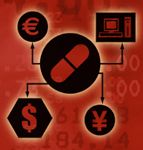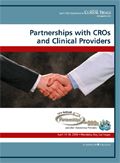Pharma Casts Out Financial Functions
Applied Clinical Trials Supplements
Outsourcing finance and accounting can provide cost savings and improve operations.
Pharmaceutical companies today are faced with a business imperative: Squeeze out as much costs as possible and increase earnings. Responding to this overwhelming pressure, pharmaceuticals now have an increased emphasis on looking for areas where they can improve operations. For many, the best strategy for achieving cost savings is outsourcing.
Business advisory firm Everest Group believes that the pharmaceutical industry is quickly reaching the tipping point of adopting Finance and Accounting Outsourcing (FAO); that is, the outsourcing of two or more Finance and Accounting (F&A) functions such as accounts payable, accounts receivable, general accounting, payroll, tax, budgeting, and internal audit.

ILLUSTRATION: PAUL A. BELCI
Outsourcing has been proven for four decades to be the fastest, least-costly path to operational and business process transformation. A significant yet unrealized opportunity has existed for some time for pharmaceutical companies to reduce SG&A (selling, general, and administrative) expenses through FAO.
What are the potential run-rate savings that can be achieved through FAO? Companies typically achieve savings of 30% to 40% for the services outsourced—and also increase their competitive advantage at the same time by reinvesting the savings into the core business.
Adoption of FAO by pharma
The pharma industry movement toward adoption of FAO is due to the convergence of:
- Ongoing significant cost pressures
- The maturity of FAO as an accepted business practice
- The maturing of large, stable, growing FAO service providers
- A new, serious look for operating efficiencies beyond building scale
- The existence of pharmaceutical examples of successful cost reduction in SG&A through outsourcing F&A.
Among recent, major, public FAO contracts were three pharmaceutical companies. Bristol-Myers Squibb (BMS) outsourced FAO to Accenture in 2005. GlaxoSmithKline (GSK) and Novartis outsourced to Genpact in 2006 and 2007, respectively. Pharma companies have been conservative in adopting FAO compared to energy and utilities, manufacturing, and hi tech. However, Everest Group believes that the GSK, BMS, and Novartis FAO deals represent the tip of a large iceberg of more pharma companies beginning to explore the potential low-hanging fruit of FAO.
Other industries have adopted FAO by following a phased approach. They tend to adopt IT outsourcing (ITO) first and then, after seeing the positive results materialize, start adopting other types of Business Process Outsourcing (BPO) over time.
Looking closely at this historical pattern reveals that most companies move to BPO by outsourcing industry-specific processes (e.g., claims administration in the insurance industry, and drug R&D services and clinical data management in pharma). Next in progression is usually FAO or Human Resources outsourcing (often starting with the payroll function), followed by the outsourcing of the procurement process. As Figure 1 shows, the pharmaceutical industry is following this pattern, with ITO deals comprising the majority of its outsourcing contracts since 1997.

Figure 1. As observed in other industries, IT outsourcing has served as a precursor to FAO and other BPO transactions in Pharma as well.
The FAO concept has been thoroughly road tested by other industries and continues to move forward at a growth rate of 30% per year. The outsourcing transactions in pharma have been in line with the phased approach with which companies and entire industries adopt outsourcing, starting with ITO and moving into BPO. Everest Group expects to see a continuation and acceleration of both ITO and BPO in the pharma industry going forward.
FAO has now reached the rapid-growth phase. It has established a firm and stable foundation and is continuing to grow rapidly. The market has grown by more than 45% since the beginning of 2005. The recent GSK, BMS, and Novartis deals represent but three of the early movers in industry adoption.
Over the past few years, the pharmaceutical industry's efforts to improve operational costs have been focused on building scale in core operations through mergers/acquisitions, increasing efficiencies through ERP (Enterprise Resource Planning) implementations, and improving focus by divesting noncore operations. Even with all that the industry has done to improve scale and efficiency, an ugly reality exists: SG&A costs as a percent of revenues are still rising, thereby putting significant pressure on pharmaceutical chief financial officers to quickly find additional ongoing cost savings.
Industry trends exert pressure
The current state of the pharmaceutical industry finds seven environmental factors are pressuring the pharma companies:
- Slowing growth rates
- Weak product pipelines
- Impending patent expirations
- Competition from generic drugs
- Consolidation of health care insurers
- Increased price cutting by nationalized health care providers
- Aging Western populations.
The impact of these pressures includes missed growth expectations, declining margins, industry layoffs, and cost-cutting pressures from insurance companies and politicians. These pressures are already affecting the industry's financials.
Pharma companies also face strong competitive pressures and must respond to these challenges by reducing the cost of product development and also bringing products to market faster. Responding to the seven environmental factors and the increasing competitive pressures requires companies to become committed to operations excellence—that is, continuous improvement and minimizing or eliminating unnecessary costs.
Merits of FAO solutions
How can pharmaceutical companies leverage FAO to contribute to these objectives? Pharmaceuticals that outsource F&A can start with the low-hanging fruit, simply using FAO to drive cost reduction. Consolidation, standardization, streamlining, and labor arbitrage will have a direct cost impact. On average, approximately six F&A processes are currently outsourced per FAO contract:
- Accounts payable
- Accounts receivable
- General accounting
- Management reporting and analysis
- Fixed assets
- Payroll.
The larger the F&A department of the pharmaceutical company, the greater the cost-reduction benefits it reaps by outsourcing. However, FAO is not just about lowering transaction costs. Companies can deliver additional value and broader business impact with end-to-end process transformation while maintaining cost savings. FAO can also create strategic impact by facilitating cash flow for new product development.
Outsourcing service providers offer a broad range of capability, including judgment-based processes such as capital budgeting, treasury and risk management, regulatory compliance, revenue-cycle management, and business analytics. The value achieved by outsourcing these judgment intensive F&A processes can create a strategic impact for some companies.
Significant strategic value achieved by companies that have adopted FAO include best practices that ensure better management of cash and receivables, resulting in reduced working capital and reduced operational and financial risk. Making the accounting process more effective through order-to-cash outsourcing can shorten cash flow cycle time, reduce revenue leakage, and provide an improved view of enterprise-wide information. Making the accounting process more efficient through report-to-record outsourcing can improve work flows, process documentation, and the speed of transaction processing; shorten the month-end close process; and reduce accounts payable errors.
Other business benefits that companies achieve by leveraging FAO include management's increased ability to focus on strategic business decisions. Another value beyond cost reduction is regulatory compliance and process transparency enabled by the provider's adoption of standard tools and processes, formalized process change control, best practices, and improved process documentation. Increased regulation (such as the Sarbanes-Oxley Act of 2002) and shareholder demand for transparency are strong drivers for pharmaceutical companies to standardize their F&A functions, provide third-party management of the functions, and ensure best practices in financial management and reporting.
FAO supplier landscape
There are currently more than 20 well-established, credible FAO service providers. Competition is healthy, keeping prices competitive and everyone focused on innovation.
Many FAO service providers have built leverage points across their clients with an industry focus, taking advantage of "like" processes and common standards. Accenture, for example, has an FAO client base in the energy sector, Capgemini in manufacturing, Genpact in financial services, Perot in health care, WNS in travel, and ACS and IBM in manufacturing and retail.
Savvy service providers for the pharmaceutical industry possess pharma domain expertise, not just F&A process expertise. Today, Accenture and Genpact lead the pack in this regard, but other F&A providers are looking to acquire domain expertise.
FAO service providers come in two flavors: best-of-breed and integrated. The best-of-breed providers, such as Genpact, focus solely on F&A processes. Integrated service providers, such as Accenture and IBM, have multitower capabilities, supporting FAO services along with one or more additional processes such as HR, procurement or IT, and thus provide one-stop shopping to clients outsourcing multiple processes.
Although some buyers convert to the provider's F&A systems, the majority currently retain ownership of their existing ERP platform and core F&A systems. However, buyers do use the proprietary "add-ons" of the service providers. These "add-ons" include project management tools, analytics, data warehousing, data mining, user portals/dashboards, document digitization, and workflow engines.
The offshore factor
All 20 service providers have adopted the offshore model. The more established players have a mix of offshore and onshore resources. More than 75% of current FAO contracts include an offshore delivery component, and more than 80% of the FAO workforce is located in offshore locations.
India is the FAO offshore hub, but Eastern Europe has emerged as a key growth area for F&A services over the past two years, primarily serving Western European clients with services requiring specific language skills. China, Mexico, the Philippines, Argentina, and Australia are also viable offshore delivery locations.
Labor arbitrage—leveraging the vast pools of highly skilled workers at a reduced operating cost per Full-Time Equivalent (FTE)—continues to be the key driver of savings in FAO. The offshoring model has a significant impact on direct cost savings in F&A transactions.
It is important to note that direct cost savings from labor arbitrage is a one-time benefit of FAO. Process excellence (increased accuracy and reduced cycle time, for example) and an improved operating model (increased scale and specialization, for example) are two ongoing key components of the value proposition in offshore delivery of FAO. Looking beyond the one-time benefit of labor arbitrage, buyers are seeking outsourcing relationships that offer continuous improvement throughout the contract term.
Addressing process inefficiencies
As process inefficiencies result in high operational costs, cost-reduction strategies are critical to pharmaceuticals' ongoing business success. Good business practices of leading companies worldwide in all industries suggest consideration of FAO as a strategy with multiple levers for achieving cost reduction.
With multiple levers of value creation, there are numerous opportunities to create business and strategic impact and value for pharma stakeholders through FAO. In addition, the pharma companies adopting FAO today are stepping into a very competitive buyer's market. Service providers are fighting for market share, making it a great time to be a buyer.
As evidence of the tipping point for pharma adoption, service providers are reporting an uplift in FAO inquiries from pharma companies. They also note that, although FAO is usually approached in any industry as part of a solution to address cost pressures, pharma companies are already looking toward the future and asking for value-add services in addition to cost reduction. Revenue cycle management, third-party spend management, and risk management are three hot areas of interest.
In addition, as FAO is maturing, service providers are focusing on delivering innovation beyond efficient process management. An example of such innovation is developing technology enhancements to F&A systems and processes to drive greater accounting data unification across multiple, disparate systems, geographies, and business units.
Early adopters of FAO—GSK, BMS, and Novartis—have put in place strategies that will allow them to weather competitive and environmental pressures in a more cost-efficient and strategic manner and be ahead of the curve in innovation.
Paul Nowacki, CFA, leads the finance and accounting outsourcing (FAO) consulting practice at Everest Group, 150 South Wacker Drive, 17th Floor, Chicago, IL 60606, email: pnowacki@everestgrp.com
